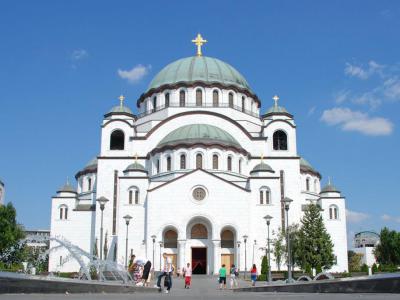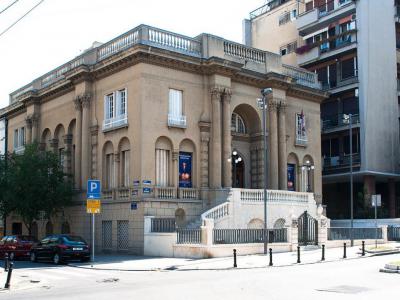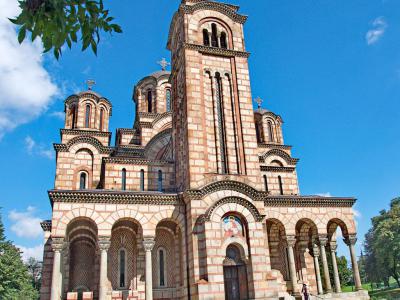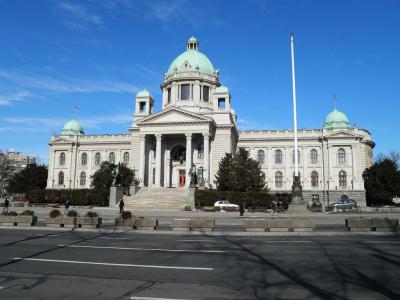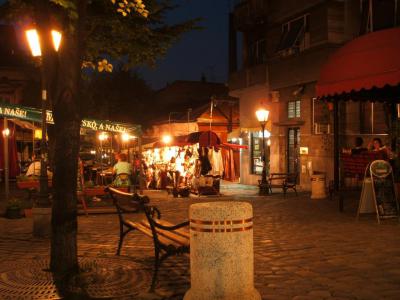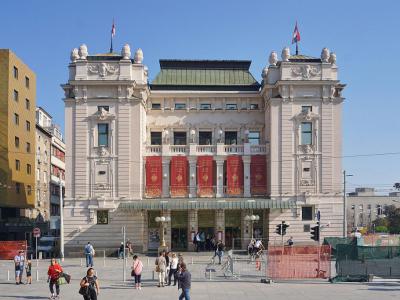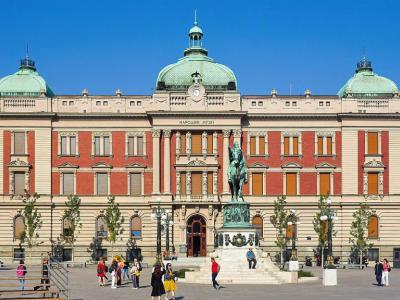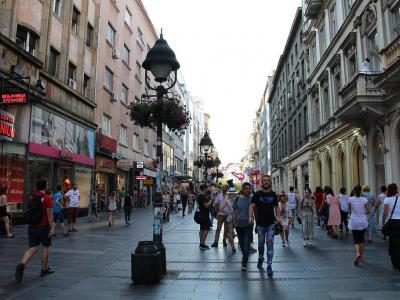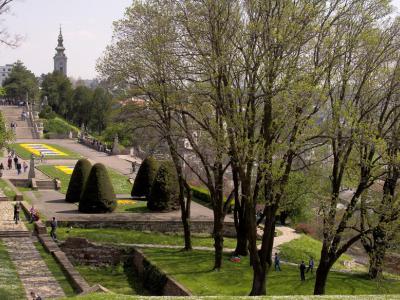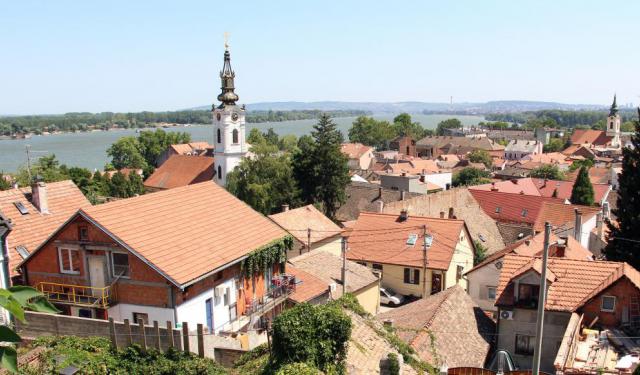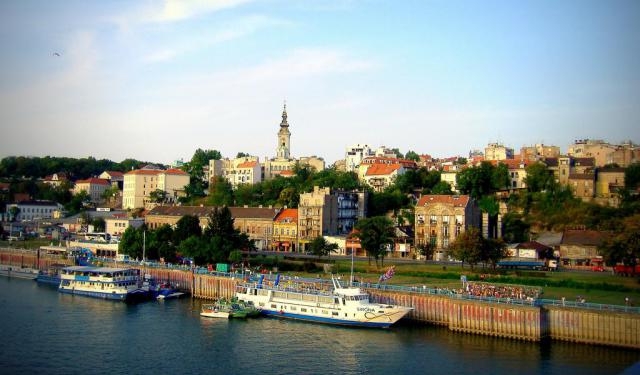
Belgrade Introduction Walking Tour (Self Guided), Belgrade
Belgrade has been a city of strategic importance for millennia with its location at the confluence of the Sava and Danube rivers. In fact, it is one of the oldest continually inhabited cities on the planet.
Nomadic tribes inhabited the area as far back as 20,000 to 50,000 years ago. Some of these may have been Neanderthals rather than modern humans. By the sixth century BC, the Vinca culture inhabited the area. They were followed by the Thraco-Dacians, Celts, and finally, the Romans. The city, then called Singidunum, was part of the Empire and eventually passed to the Byzantine Empire.
The Middle Ages were a time of upheaval as power struggles between the Byzantine Empire and Germanic tribes ravaged the city. The Ottomans took the city in 1521, but they continued to fight the Austrians for hundreds of years. Serbian Uprisings in 1807 and 1815 eventually led to some sovereignty, first with the Principality and, eventually, the Kingdom of Serbia.
Prince Michael, properly Prince Mihailo Obrenovic, expanded Belgrade and helped ensure its future. A monument to his achievements stands in Republic Square, outside the National Theatre and National Museum.
During World War I, the German-Austrian forces invaded the area. French forces liberated it in 1918, and the city became the capital of the Kingdom of Yugoslavia after the war.
The Germans invaded again in World War II and bombed the city heavily. The Red Army liberated it in 1944. Belgrade became a major industrial center after the war as the capital of the new Socialist Yugoslavia.
Belgrade was the site of many protests against leader Slobodan Milosevic in the 1990s. NATO forces bombed the city during the Kosovo War in 1999, but the 2000 presidential elections resulted in the ousting of Milosevic.
Today, Belgrade is a busy metropolitan city that is experiencing a renaissance. In Kalemegdan Park, you can see evidence of the town's struggles and its distinctive historic fortress. The dominating Cathedral of Saint Sava is a must-see for both its grandeur and Byzantine influences. Also, don't miss strolling streets like Prince Michael Street and Skadarlija.
You'll love the history and varied culture in Belgrade--it's truly unlike any other place you'll visit. Join us on a walking tour of the city's best sights!
Nomadic tribes inhabited the area as far back as 20,000 to 50,000 years ago. Some of these may have been Neanderthals rather than modern humans. By the sixth century BC, the Vinca culture inhabited the area. They were followed by the Thraco-Dacians, Celts, and finally, the Romans. The city, then called Singidunum, was part of the Empire and eventually passed to the Byzantine Empire.
The Middle Ages were a time of upheaval as power struggles between the Byzantine Empire and Germanic tribes ravaged the city. The Ottomans took the city in 1521, but they continued to fight the Austrians for hundreds of years. Serbian Uprisings in 1807 and 1815 eventually led to some sovereignty, first with the Principality and, eventually, the Kingdom of Serbia.
Prince Michael, properly Prince Mihailo Obrenovic, expanded Belgrade and helped ensure its future. A monument to his achievements stands in Republic Square, outside the National Theatre and National Museum.
During World War I, the German-Austrian forces invaded the area. French forces liberated it in 1918, and the city became the capital of the Kingdom of Yugoslavia after the war.
The Germans invaded again in World War II and bombed the city heavily. The Red Army liberated it in 1944. Belgrade became a major industrial center after the war as the capital of the new Socialist Yugoslavia.
Belgrade was the site of many protests against leader Slobodan Milosevic in the 1990s. NATO forces bombed the city during the Kosovo War in 1999, but the 2000 presidential elections resulted in the ousting of Milosevic.
Today, Belgrade is a busy metropolitan city that is experiencing a renaissance. In Kalemegdan Park, you can see evidence of the town's struggles and its distinctive historic fortress. The dominating Cathedral of Saint Sava is a must-see for both its grandeur and Byzantine influences. Also, don't miss strolling streets like Prince Michael Street and Skadarlija.
You'll love the history and varied culture in Belgrade--it's truly unlike any other place you'll visit. Join us on a walking tour of the city's best sights!
How it works: Download the app "GPSmyCity: Walks in 1K+ Cities" from Apple App Store or Google Play Store to your mobile phone or tablet. The app turns your mobile device into a personal tour guide and its built-in GPS navigation functions guide you from one tour stop to next. The app works offline, so no data plan is needed when traveling abroad.
Belgrade Introduction Walking Tour Map
Guide Name: Belgrade Introduction Walking Tour
Guide Location: Serbia » Belgrade (See other walking tours in Belgrade)
Guide Type: Self-guided Walking Tour (Sightseeing)
# of Attractions: 10
Tour Duration: 2 Hour(s)
Travel Distance: 4.0 Km or 2.5 Miles
Author: valery
Sight(s) Featured in This Guide:
Guide Location: Serbia » Belgrade (See other walking tours in Belgrade)
Guide Type: Self-guided Walking Tour (Sightseeing)
# of Attractions: 10
Tour Duration: 2 Hour(s)
Travel Distance: 4.0 Km or 2.5 Miles
Author: valery
Sight(s) Featured in This Guide:
- Cathedral of Saint Sava
- Nikola Tesla Museum
- St. Mark's Church
- Skupština (House of the National Assembly)
- Skadarlija Street
- National Theatre
- National Museum
- Republic Square
- Prince Michael Street
- Kalemegdan Park
1) Cathedral of Saint Sava (must see)
Modeled after the Hagia Sophia in Istanbul, the Temple of Saint Sava is Belgrade's most imposing landmark. It is dedicated to Saint Sava, the founder of the Serbian Orthodox Church and a national hero.
The church was planned to be the bishop's seat and the main cathedral for the Serbian Orthodox religion. You can trace the initial plans for building a church back to 1894. But the first stones of the church weren't laid until 1935, and construction was paused during the war years and communist rule.
The tide turned for the church in 1985 when a liturgy was held, attended by over 100,000 people. This proved that the church still had significant power with the population, and the communist leaders had to back down and allow the church construction to go on.
During construction, the greatest achievement was undoubtedly the lifting of the church's enormous concrete dome in 1989. The dome is 39.5 meters (130 feet) in diameter, weighs 4,000 tons, and is clad in copper. It was lifted into place using hydraulic machines, a process that took 20 days. The construction technology that made it possible was created specifically for the task.
The church sits on the Vračar plateau, the site where Ottomans burnt Saint Sava's remains in 1594. Sava lived in the 13th century and was known as the Enlightener. Besides being the first Archbishop of the Serbian Orthodox Church, he is remembered as the founder of Serbian law, a diplomat, and one of the most important people in the country's history.
Saint Sava's is one of the largest Eastern Orthodox churches and one of the largest churches in the world. When the Hagia Sophia was again converted to a mosque in 2020, church leaders hoped that Saint Sava's would replace it as a "New Hagia Sophia."
One of the most notable interior features of the church is the use of light, thanks to the enormous dome and four apses. In addition, the interior is clad with 130,000 square feet of golden mosaics. The impressive installation was funded thanks to gifts from the Russian Federation and the Republic of Serbia.
The church was planned to be the bishop's seat and the main cathedral for the Serbian Orthodox religion. You can trace the initial plans for building a church back to 1894. But the first stones of the church weren't laid until 1935, and construction was paused during the war years and communist rule.
The tide turned for the church in 1985 when a liturgy was held, attended by over 100,000 people. This proved that the church still had significant power with the population, and the communist leaders had to back down and allow the church construction to go on.
During construction, the greatest achievement was undoubtedly the lifting of the church's enormous concrete dome in 1989. The dome is 39.5 meters (130 feet) in diameter, weighs 4,000 tons, and is clad in copper. It was lifted into place using hydraulic machines, a process that took 20 days. The construction technology that made it possible was created specifically for the task.
The church sits on the Vračar plateau, the site where Ottomans burnt Saint Sava's remains in 1594. Sava lived in the 13th century and was known as the Enlightener. Besides being the first Archbishop of the Serbian Orthodox Church, he is remembered as the founder of Serbian law, a diplomat, and one of the most important people in the country's history.
Saint Sava's is one of the largest Eastern Orthodox churches and one of the largest churches in the world. When the Hagia Sophia was again converted to a mosque in 2020, church leaders hoped that Saint Sava's would replace it as a "New Hagia Sophia."
One of the most notable interior features of the church is the use of light, thanks to the enormous dome and four apses. In addition, the interior is clad with 130,000 square feet of golden mosaics. The impressive installation was funded thanks to gifts from the Russian Federation and the Republic of Serbia.
2) Nikola Tesla Museum (must see)
The Nikola Tesla Museum is a science museum and the final resting place of Nikola Tesla. The facility is dedicated to Tesla's life and work. It contains more than 160,000 original documents, 1,200 technical exhibits, 2,500 photos or drawings, and over 2,000 books or journals.
The building is a 1927 villa. The museum was founded in 1952, and exhibitions began in 1955.
Nikola Tesla was an inventor and engineer who lived from 1856 to 1943. He was Serbian, born in the village of Smiljan. He studied in Austria and audited classes at Charles-Ferdinand University in Prague. His first jobs were for a telegraph company in Budapest and the Continental Edison Company in Paris later on.
He emigrated to the United States in 1884 to work for Edison Machine Works in New York. He became a naturalized US citizen in 1891. He broke with Edison and founded his own series of ventures, eventually filing over 300 patents. He is remembered most for his work on alternating-current motors and power transmitting equipment licensed to Westinghouse.
Tesla died in 1943 in New York City. His remains are interred at the museum in his favorite geometric shape--a gilded spherical urn.
English and other language tours are given hourly, and interactive demonstrations of his inventions follow each tour. One important note--the museum only accepts cash for ticket sales.
The building is a 1927 villa. The museum was founded in 1952, and exhibitions began in 1955.
Nikola Tesla was an inventor and engineer who lived from 1856 to 1943. He was Serbian, born in the village of Smiljan. He studied in Austria and audited classes at Charles-Ferdinand University in Prague. His first jobs were for a telegraph company in Budapest and the Continental Edison Company in Paris later on.
He emigrated to the United States in 1884 to work for Edison Machine Works in New York. He became a naturalized US citizen in 1891. He broke with Edison and founded his own series of ventures, eventually filing over 300 patents. He is remembered most for his work on alternating-current motors and power transmitting equipment licensed to Westinghouse.
Tesla died in 1943 in New York City. His remains are interred at the museum in his favorite geometric shape--a gilded spherical urn.
English and other language tours are given hourly, and interactive demonstrations of his inventions follow each tour. One important note--the museum only accepts cash for ticket sales.
3) St. Mark's Church
Located in Tasmajdan Park near Parliament, the Church of St. Mark is a Serbian Orthodox church built in the Byzantine style. The building you see today was mostly completed by 1940, but there was a church dating from 1835 on this same site.
That original church was built of wood and also dedicated to St. Mark. It was built in an existing cemetery. Here, King Alexander Obrenovic I and Queen Draga Obrenovic were buried after they were assassinated during the May Coup in 1903.
The original church was hit by German bombs and badly damaged on Palm Sunday in 1941. The rubble was cleared in 1942.
At the time, the new church's exterior had been completed, but finishing work was stalled due to the war. Nevertheless, divine service took place inside during the war. Officially, the building was consecrated in 1948.
The church has three altars. One of the altars contains a mosaic that is believed to be one of the largest in the world, spanning 1,400 square feet (130 square meters). It is made of Venetian glass and is titled "Mother of God, Larger than Heaven."
The park surrounding the church is worth a stroll. The grounds were rearranged in 2017. Large amounts of pavement were removed, and green spaces with granite slabs were added in their place. To the church's right is a ceremonial space, patterned after Capitoline Hill in Rome. It is meant to be an expansion of the church.
That original church was built of wood and also dedicated to St. Mark. It was built in an existing cemetery. Here, King Alexander Obrenovic I and Queen Draga Obrenovic were buried after they were assassinated during the May Coup in 1903.
The original church was hit by German bombs and badly damaged on Palm Sunday in 1941. The rubble was cleared in 1942.
At the time, the new church's exterior had been completed, but finishing work was stalled due to the war. Nevertheless, divine service took place inside during the war. Officially, the building was consecrated in 1948.
The church has three altars. One of the altars contains a mosaic that is believed to be one of the largest in the world, spanning 1,400 square feet (130 square meters). It is made of Venetian glass and is titled "Mother of God, Larger than Heaven."
The park surrounding the church is worth a stroll. The grounds were rearranged in 2017. Large amounts of pavement were removed, and green spaces with granite slabs were added in their place. To the church's right is a ceremonial space, patterned after Capitoline Hill in Rome. It is meant to be an expansion of the church.
4) Skupština (House of the National Assembly)
The House of National Assembly is located on Nikola Pasic Square. It's a 149,000 square foot (13,800 square meters) design with baroque accents.
The original designs for the building, made by architect Konstantin Jovanovic in 1891, had to be modified due to budget constraints. Further modifications during the planning phase resulted in the plans for a bicameral parliament that eventually morphed into the country's present-day unicameral legislature.
Construction began in 1907, and the exterior of the building was completed in 1939. The interior was completed in 1938.
The interior of the building was designed entirely by Russian architect Nikolai Krasnov. Using watercolors instead of technical blueprints, Krasnov envisioned every detail down to the chandeliers and lamps.
The design has four stories, with mezzanines in between each level. There are 100 offices, four committee rooms, and large and small debating chambers. An enormous library on the first floor has over 60,000 volumes, and the building has many frescoes, paintings, and sculptures throughout.
The National Assembly of Serbia is a unicameral legislature made of deputies. Each deputy serves a four-year term and elects a president who presides over the seasons.
Don't miss the opportunity to walk past the building at night--the exterior is lit and makes for a wonderful view. During the holidays, the Christmas lights on the House of the National Assembly are not to be missed.
The original designs for the building, made by architect Konstantin Jovanovic in 1891, had to be modified due to budget constraints. Further modifications during the planning phase resulted in the plans for a bicameral parliament that eventually morphed into the country's present-day unicameral legislature.
Construction began in 1907, and the exterior of the building was completed in 1939. The interior was completed in 1938.
The interior of the building was designed entirely by Russian architect Nikolai Krasnov. Using watercolors instead of technical blueprints, Krasnov envisioned every detail down to the chandeliers and lamps.
The design has four stories, with mezzanines in between each level. There are 100 offices, four committee rooms, and large and small debating chambers. An enormous library on the first floor has over 60,000 volumes, and the building has many frescoes, paintings, and sculptures throughout.
The National Assembly of Serbia is a unicameral legislature made of deputies. Each deputy serves a four-year term and elects a president who presides over the seasons.
Don't miss the opportunity to walk past the building at night--the exterior is lit and makes for a wonderful view. During the holidays, the Christmas lights on the House of the National Assembly are not to be missed.
5) Skadarlija Street (must see)
Located in Belgrade's Old Town, Skadarlija is a former municipality. Its vintage and urban feel give it a welcoming vibe, much like Paris' Montmartre. This part of town is one of Belgrade's busiest tourist areas, attracting over 20,000 people daily.
Skadralija Street winds for only 400 meters, running from below Republic Square and connecting Despot Stefan Boulevard with Dušanova Street.
Gypsies built the first houses in the area around 1717, followed by the Serbs and the Turks. In those days, this part of town was known as Gypsy Quarter.
The area has been reconstructed in recent years. A public outcry resulted when plans to pave the distinctive multi-colored cobblestone street came to light. Imported stones from Greece were used, detracting from the original character and drawing much condemnation from the locals.
But it's still a wonderful place to visit and a great place to enjoy the relaxed side of Belgrade. The sides of Skadarlija are lined with restaurants, hotels, and art galleries. It's the perfect place to enjoy lunch at a sidewalk cafe or watch street performers. You'll likely see musicians dressed in traditional Serb costumes playing traditional instruments.
Skadarlija has a Bohemian, down-to-earth atmosphere that will give you all the city's flavors without the poshness found elsewhere. It is favored by young families and couples and is a well-known haunt for poets and writers in town.
Try the local beer (locally known as "pivo") or the grilled meats (locally known as "roštilj"). The street is a pedestrian-only zone, so you can stroll, shop, and enjoy at your own pace.
Skadralija Street winds for only 400 meters, running from below Republic Square and connecting Despot Stefan Boulevard with Dušanova Street.
Gypsies built the first houses in the area around 1717, followed by the Serbs and the Turks. In those days, this part of town was known as Gypsy Quarter.
The area has been reconstructed in recent years. A public outcry resulted when plans to pave the distinctive multi-colored cobblestone street came to light. Imported stones from Greece were used, detracting from the original character and drawing much condemnation from the locals.
But it's still a wonderful place to visit and a great place to enjoy the relaxed side of Belgrade. The sides of Skadarlija are lined with restaurants, hotels, and art galleries. It's the perfect place to enjoy lunch at a sidewalk cafe or watch street performers. You'll likely see musicians dressed in traditional Serb costumes playing traditional instruments.
Skadarlija has a Bohemian, down-to-earth atmosphere that will give you all the city's flavors without the poshness found elsewhere. It is favored by young families and couples and is a well-known haunt for poets and writers in town.
Try the local beer (locally known as "pivo") or the grilled meats (locally known as "roštilj"). The street is a pedestrian-only zone, so you can stroll, shop, and enjoy at your own pace.
6) National Theatre
The first stones of the National Theatre building were laid in 1868, but the building has gone through many changes in its long history. As such, it stands a monument to Serbia in general--a symbol of Serbian culture, spirituality, and tradition.
You can trace the theatre's history in Belgrade back to a performance seen by Prince Michael. In 1868 the Serbian Theatre from Novi Sad, the second largest city in Serbia, performed in town. Prince Michael was so impressed that he invited its founder, Jovan Dordevic, to create a theatre in Belgrade.
The Prince even chose the site of the theatre. It was located on what became Republic Square, on the location where one of the outer gates to the Belgrade Fortress once stood. Unfortunately, Prince Michael did not live to see his theatre's completion.
Work on the building was begun and stopped during the Great War and interbellum years. During World War II, the German military effectively took control of construction, and soldiers repaired damage and finished the building in 1942. Regardless, the building still sustained heavy damage from bombings during the war.
After the war, the building was rebuilt and reopened in 1989. During the 1999 NATO bombings, the theatre was opened daily to the public for operas, plays, and ballets.
Today the National Theatre is open for concerts, drama, opera, and ballet performances. The Grand Hall has three levels, with 219 seats on the ground floor and three balconies. The Raša Plaović Stage has 281 seats with no balconies and is used for smaller drama productions.
Don't miss the backstage tour for a closer look at the inner workings of this beautiful theatre.
You can trace the theatre's history in Belgrade back to a performance seen by Prince Michael. In 1868 the Serbian Theatre from Novi Sad, the second largest city in Serbia, performed in town. Prince Michael was so impressed that he invited its founder, Jovan Dordevic, to create a theatre in Belgrade.
The Prince even chose the site of the theatre. It was located on what became Republic Square, on the location where one of the outer gates to the Belgrade Fortress once stood. Unfortunately, Prince Michael did not live to see his theatre's completion.
Work on the building was begun and stopped during the Great War and interbellum years. During World War II, the German military effectively took control of construction, and soldiers repaired damage and finished the building in 1942. Regardless, the building still sustained heavy damage from bombings during the war.
After the war, the building was rebuilt and reopened in 1989. During the 1999 NATO bombings, the theatre was opened daily to the public for operas, plays, and ballets.
Today the National Theatre is open for concerts, drama, opera, and ballet performances. The Grand Hall has three levels, with 219 seats on the ground floor and three balconies. The Raša Plaović Stage has 281 seats with no balconies and is used for smaller drama productions.
Don't miss the backstage tour for a closer look at the inner workings of this beautiful theatre.
7) National Museum
Located on Republic Square next to the National Theatre is the National Museum. It is the largest and oldest museum in Serbia, established in 1844. The present building had its grand opening in 1952 and was completely rebuilt and reopened in 2018.
The collection includes more than 400,000 objects. The collection comprises 34 sets, including archeological, numismatic, artistic, and historical objects. Masterpieces from all over the world are included in the collection.
In many of the permanent exhibits, there is a focus on telling the story of the development of this part of Europe. Artifacts narrate the timeline from the Paleolithic period to modern times.
The art collection includes works from French, Dutch, Russian, German, Flemish, Italian, Japanese, and Chinese masters, along with many others. The collection includes pieces by Picasso, Monet, Renoir, Rouault, Degas, and Cezanne, just to name a few.
The National Museum is a must-see for art buffs and history enthusiasts. Even though the collection is extensive, most guests find that one or two hours is sufficient to enjoy the well-organized collections. Descriptions are conveniently available in English. Entrance is free on Sundays, and the museum is closed every Monday.
The collection includes more than 400,000 objects. The collection comprises 34 sets, including archeological, numismatic, artistic, and historical objects. Masterpieces from all over the world are included in the collection.
In many of the permanent exhibits, there is a focus on telling the story of the development of this part of Europe. Artifacts narrate the timeline from the Paleolithic period to modern times.
The art collection includes works from French, Dutch, Russian, German, Flemish, Italian, Japanese, and Chinese masters, along with many others. The collection includes pieces by Picasso, Monet, Renoir, Rouault, Degas, and Cezanne, just to name a few.
The National Museum is a must-see for art buffs and history enthusiasts. Even though the collection is extensive, most guests find that one or two hours is sufficient to enjoy the well-organized collections. Descriptions are conveniently available in English. Entrance is free on Sundays, and the museum is closed every Monday.
8) Republic Square
One of the main town squares in Belgrade, Republic Square is home to some of the city's most notable attractions. Both the National Theatre and the National Museum are here. It borders the Old Town neighborhood and connects to the center of town by traffic and pedestrian streets. It's one of the busiest places in the city and has over 20 bus or trolley lines running through it.
A statue of Prince Michael (Prince Mihailo Obernovic III) stands in the square. Italian sculptor Enrico Pazzi made the statue in 1882. The monument is in honor of the Prince's expulsion of the Turks from Serbia and the seven cities he liberated. The Prince's hand points towards Constantinople, supposedly symbolically telling the Turks to leave.
When the memorial to Prince Michael was built in 1882, excavations revealed brick tombs of Roman and Celtic origins. The square has been part of daily life in the area since Roman times. Back then, the town was named Singidunum.
The name of the square is still a matter of debate in Belgrade. Originally the square was named Theatre Square, but a movement has been afoot to rename it Freedom Square. It was here in 1991 that pro-democracy demonstrations were held supporting the ousting of Slobodan Milosevic.
A statue of Prince Michael (Prince Mihailo Obernovic III) stands in the square. Italian sculptor Enrico Pazzi made the statue in 1882. The monument is in honor of the Prince's expulsion of the Turks from Serbia and the seven cities he liberated. The Prince's hand points towards Constantinople, supposedly symbolically telling the Turks to leave.
When the memorial to Prince Michael was built in 1882, excavations revealed brick tombs of Roman and Celtic origins. The square has been part of daily life in the area since Roman times. Back then, the town was named Singidunum.
The name of the square is still a matter of debate in Belgrade. Originally the square was named Theatre Square, but a movement has been afoot to rename it Freedom Square. It was here in 1991 that pro-democracy demonstrations were held supporting the ousting of Slobodan Milosevic.
9) Prince Michael Street (must see)
Prince Michael Street is one of the main pedestrian zones in the city, as well as being one of the main attractions in town and a popular shopping district.
The street follows the path of the original Roman city layout. The Roman town here was called Singidunum. Roman graves in the area have been dated from the first and second centuries. Many modern buildings along the street, such as the Rajićeva shopping mall, unearthed remains of antique and late antique structures and foundations.
Along the route, you will see private homes dating from the late 1800s. Many are evocative of various architectural styles, as the street has always attracted the wealthy tycoons of the country. You'll see some in the renaissance style, like the Marko Stojanović home. It's now the home to the Gallery of the Academy of Fine Arts.
The Serbian Academy of Sciences and Arts is located in Number 35. The building was completed in 1924 in the academic style and houses its gallery, lecture hall, antique shop, and bookstore.
Many of the beautiful buildings along Prince Michael Street are now home to popular restaurants and cafes. For example, the Ruski Car at Number 38 is a popular cafe in a 1926 Art Deco building.
Walking Prince Michael Street is a must-do activity in Belgrade. It has been named one of the most beautiful pedestrian zones in Eastern Europe. In 2006, Business Week named the street one of the best places in Europe for Christmas shopping.
The street follows the path of the original Roman city layout. The Roman town here was called Singidunum. Roman graves in the area have been dated from the first and second centuries. Many modern buildings along the street, such as the Rajićeva shopping mall, unearthed remains of antique and late antique structures and foundations.
Along the route, you will see private homes dating from the late 1800s. Many are evocative of various architectural styles, as the street has always attracted the wealthy tycoons of the country. You'll see some in the renaissance style, like the Marko Stojanović home. It's now the home to the Gallery of the Academy of Fine Arts.
The Serbian Academy of Sciences and Arts is located in Number 35. The building was completed in 1924 in the academic style and houses its gallery, lecture hall, antique shop, and bookstore.
Many of the beautiful buildings along Prince Michael Street are now home to popular restaurants and cafes. For example, the Ruski Car at Number 38 is a popular cafe in a 1926 Art Deco building.
Walking Prince Michael Street is a must-do activity in Belgrade. It has been named one of the most beautiful pedestrian zones in Eastern Europe. In 2006, Business Week named the street one of the best places in Europe for Christmas shopping.
10) Kalemegdan Park
Kalemegdan Park is located on a tall plateau at the confluence of the Sava and the Danube Rivers. Historically, the park area was the town field inside the Belgrade Fortress. The area separated the Fortress from the surrounding settlements, creating a buffer zone.
The park is divided into the Great and Little Kalemagdan. Together, the green space has 3,424 individual trees of 80 different species. Most are between 20 and 60 years of age.
Great Kalemegdan Park is on the southern corner of the property. Here you will find a military museum, a museum dedicated to hunting and forestry, and several geometrical promenades. A gondola is planned to connect this part of the park with the neighborhood of Ušće across the Sava.
Little Kalemagdan Park is on the east side and borders the urban part of Belgrade. Belgrade Zoo is located here, along with an art pavilion. There is also a Ferris Wheel, installed in 1964, that is one of only six like it left in the world.
The park is also one of the best places to see remnants of the Belgrade Fortress. The Fortress is the core of Old Town Belgrade and was rebuilt numerous times over the centuries. Its history spans from the earliest Roman and Celtic settlements to its present use as home to the museums within the park.
The park is divided into the Great and Little Kalemagdan. Together, the green space has 3,424 individual trees of 80 different species. Most are between 20 and 60 years of age.
Great Kalemegdan Park is on the southern corner of the property. Here you will find a military museum, a museum dedicated to hunting and forestry, and several geometrical promenades. A gondola is planned to connect this part of the park with the neighborhood of Ušće across the Sava.
Little Kalemagdan Park is on the east side and borders the urban part of Belgrade. Belgrade Zoo is located here, along with an art pavilion. There is also a Ferris Wheel, installed in 1964, that is one of only six like it left in the world.
The park is also one of the best places to see remnants of the Belgrade Fortress. The Fortress is the core of Old Town Belgrade and was rebuilt numerous times over the centuries. Its history spans from the earliest Roman and Celtic settlements to its present use as home to the museums within the park.
Walking Tours in Belgrade, Serbia
Create Your Own Walk in Belgrade
Creating your own self-guided walk in Belgrade is easy and fun. Choose the city attractions that you want to see and a walk route map will be created just for you. You can even set your hotel as the start point of the walk.
Kalemegdan Park and Belgrade Fortress Walking Tour
The most beautiful park in Belgrade, Kalemegdan Park, or simply Kalemegdan, is also the largest park and the most important cultural and historical complex in the city. The actual park occupies a smaller portion, in the southern corner, of another, grander monument – the Belgrade Fortress (which is some two millennia older).
The fortress itself, often erroneously referred to, even by the... view more
Tour Duration: 2 Hour(s)
Travel Distance: 2.1 Km or 1.3 Miles
The fortress itself, often erroneously referred to, even by the... view more
Tour Duration: 2 Hour(s)
Travel Distance: 2.1 Km or 1.3 Miles
Belgrade Old Town (Zemun) Walking Tour
Belgrade's Old Town, also known as Zemun, spread around Gardos Hill, is one of the city's oldest parts. Throughout the centuries, as the Balkans were part first of the Roman, then the Byzantine, and then the Austro-Hungarian empires, this area transformed into a beautiful neighborhood with narrow streets, cute buildings, and breathtaking views opening from the hill onto the Old Town and... view more
Tour Duration: 2 Hour(s)
Travel Distance: 2.4 Km or 1.5 Miles
Tour Duration: 2 Hour(s)
Travel Distance: 2.4 Km or 1.5 Miles
The Most Popular Cities
/ view all
